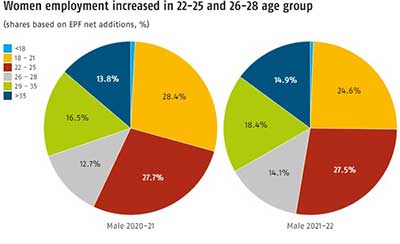Relevance: GS-2: Issues relating to the development and management of Social Sector/Services relating to Health, Education, Human Resources.
Key phrases: employment, unpaid work, equal employment opportunity, labour force participation, women workers, equal pay, social protection, inequality, economic recovery, low income, discrimination, gender equality, women’s rights, COVID-19.
Why in News?
- Coronavirus cases are falling in India and women appear set for better days. Data from Employee Provident Fund, the state-run social security organisation, till December 2021 suggests that women’s employment in the formal economy will increase at double the pace than male net job additions.
Context:
Data at a glance:

- Closing gap: In 2021-22, one female will hold a job for every four males employed. In 2020-21, the ratio was 1:5.
- Net job additions rising for women: In 2021-22 it will be on the back of a 19.4 per cent increase in new jobs for them, compared to just a 4.4 per cent increase in new jobs for males. New member additions in EPF payroll may not be as good as in 2018-19 and 2019-20, but they will still lead to women accounting for 25 per cent of the jobs in 2021-22, compared to 22.8 per cent in the previous two years.

- Younger women share yet to reclaim lost ground : In 2018-19, as many as 33.4 per cent of the women who entered the job market were aged 18-21 and 28.4 per cent were in the 22-25 age bracket. In 2021-22, the share of employment increased for women aged 22-25 and 26-28 and declined in all other categories.


- On the other hand, the demographic shift of employment from younger to old males has continued. In 2018-19, a majority of jobs went to men aged 18-25, but growth in the last few years has been higher for men aged 26 and above.
- More gain in Rising employment indicates some deeper issues. EPF data shows that the share of jobs for women aged 26 and older was increasing till the pandemic somewhat reversed this gain.
- Asymmetric gain: Data suggests women’s gains in employment may be in fields that require less specialisation and pay lower wages. The rise in female employment will help bridge the gender gap, but wage parity shall grow if women are getting the low-skill and less-experienced roles.
Persistent Challenges to Gender Equality
- Gender roles: Gender roles and the pressures to conform to these roles for women vary across regions, religions and households. One way the pressure to conform manifests itself is through marital status. For instance, in developed and emerging economies, women who have a spouse or a partner are less likely to be employed in a paid job or be actively looking for one.
- This can often arise from the economic stability of a partner’s income that can reinforce the “male breadwinner” bias in some marital arrangements.
- In developing countries the reverse is true: the economic necessity in the region gives all women little choice but to work despite their marital status.
- Work-family balance: Across the board, both women and men report that the biggest barrier for women in paid work is the struggle to balance it with family responsibilities.
- Work such as childcare, cleaning and cooking is necessary for a household’s welfare – and therefore for the well-being of societies as a whole – but women still shoulder the brunt of this often invisible and undervalued workload.
- Lack of transport: In developing and emerging countries, the lack of safe and accessible transportation is the most challenging factor for the small percentage of women who report being affected by this. All too often, women risk facing harassment and even sexual assault on their daily commute.
- Inadequate Social Security Protection: Even for women who are in the workforce, the nature of their employment is such that most of them are out of the purview of labour laws, including the recently passed Social Security Code.
- Lack of affordable care: Globally, the lack of affordable care for children or family members is an obstacle for women, both for those looking for a job and those in paid work.
- In fact, it decreases a woman’s participation chances by almost 5 percentage points in developing countries, and 4 percentage points in developed countries (data from the World Employment and Social Outlook: Trends for Women 2017).
Way Forward:
The brief emphasizes that “building forward fairer” means placing gender equality at the core of the recovery effort and putting in place gender-responsive strategies. These include:
- Investing in the care economy because the health, social work and education sectors are important generators of jobs, especially for women, and because care leave policies and flexible working arrangements can encourage a more even division of work at home between women and men.
- Working towards universal access to comprehensive, adequate and sustainable social protection for all to reduce the current gender gap in social protection coverage.
- Promoting equal pay for work of equal value.
- Eliminating violence and harassment in the world of work. Domestic violence and work-related gender-based violence and harassment worsened during the pandemic, further undermining women’s ability to engage in paid employment.
- Promoting women’s participation in decision-making bodies, social dialogue and social partner institutions.
Source: Business-Standard
Mains Question:
Q. How has COVID-19 impacted women's employment in India? What should be the measure to maintain gender equality in employment in India? Examine.







